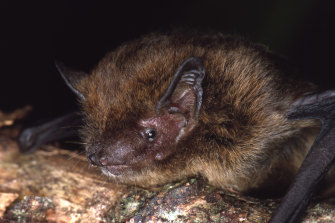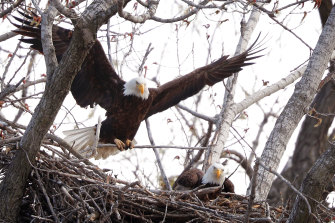
It is reasonable to imagine that the last years of the life of the last known thylacine were miserable.
It was captured in 1933, by which time hunting, land clearing and disease had already killed most of its kind. It was presumed to be a male. It stood just over 60 centimetres high and was nearly two metres from nose to tail.
They named it Benjamin and kept it in Hobart’s Beaumaris Zoo.
In grainy black and white film footage shot in 1935 he can be seen pacing his concrete cage as a fence is shaken by an onlooker seeking to provoke some response for the camera.
Benjamin was found dead on the floor on a Monday morning in September the following year after his keepers inadvertently left the door of his sleeping enclosure closed during an unusually cold night.
Two months earlier the thylacine had been listed as a protected species. Six years earlier a hunter had bagged the last wild specimen.

As close as she will get - a taxidermied Tasmanian Tiger on Display in Melbourne Museum in 2021.Credit:Joe Armao
The wanton destruction of such an extraordinary animal – a two-metre long carnivorous marsupial that roamed our forests, its males carrying their young in a pouch – is viewed as a national shame.
The writer Richard Flanagan would later describe the Tasmanian tiger as “a lost object of awe, one more symbol of our feckless ignorance and stupidity”.
You would be forgiven for thinking that it marked a turning point. You’d be wrong.
Fast-forward to 2009, when scientists began warning the federal government that the Christmas Island pipistrelle was in dire need of help.

The Christmas Island pipistrelle bat was once abundant.Credit:Lindy Lumsden
The pipistrelle is, or was, a microbat weighing just under five grams that lived in the forests of the remote Australian island just south of Java.
Though abundant until around 25 years ago in the early years of the new century scientists began warning its numbers had collapsed dramatically. Some, including Tim Flannery, appealed to the government for help. With a few hundred thousand dollars a breeding program might be established.
A committee conferred and then the environment minister of the time, Peter Garrett, rejected the proposal.
“The committee has confirmed what we feared; the pipistrelle is in severe decline and extinction in the wild is almost inevitable,” he said.
There were “unacceptably high risks involved in embarking on an immediate captive breeding program. The bats are also very hard to catch and no one knows how to keep them alive for breeding.”
It is thought the last one died in 2009.
“We don’t know precisely what happened to it,” wrote Flannery in a sad and angry piece for the Herald a few years later when the extinction was confirmed. “Perhaps it landed on a leaf at dawn after a night feeding on moths and mosquitoes, and was torn to pieces by fire ants; perhaps it succumbed to a mounting toxic burden placed on its tiny body by insecticide spraying. Or maybe it was simply worn out with age and ceaseless activity, and died quietly in its tree hollow … With its passing, an entire species winked out of existence.”
This week the federal government’s publication of the five-yearly State of the Environment report confirmed what scientists already knew – that not only has Australia failed to act fast enough on climate change, arrest its logging or properly husband its precious water resources, we are still killing off our unique fauna at a horrifying rate.
The report, the product of two years work by experts found that the number of species listed as threatened rose 8 per cent since 2016.
Worse, experts predict that over the coming two decades the northern hopping-mouse, the rock-rat, the Christmas Island flying fox, and the black-footed tree-rat could all go extinct.
This is what frustrates Professor Brendan Wintle, a global leader in conservation ecology based at the University of Melbourne. While in some countries the listing of an animal as threatened marks tends to mark a turnaround in its numbers, in Australia it is often simply a milestone on that animal’s march to extinction.

A bald eagle carrying a branch lands in its nest atop a tree overlooking the Raccoon River in 2018 at Gray’s Lake Park in Des Moines, Iowa.Credit:AP
Four years after Benjamin died of exposure in Tasmania the North American bald eagle was recognised as being at risk. Like the Thylacine its numbers had plummeted due to hunting and habitat destruction.
At the time Congress was preparing for the possibility that it might be dragged into the spreading world war and was appalled at the potential propaganda implications of the extinction of its fierce national emblem.
It resolved that the bald eagle was “no longer a mere bird of biological interest but a symbol of the American ideals of freedom” and outlawed the killing or disturbing of bald eagles or their eggs.
After the war the numbers began to decline again. The pesticide DDT had leached into the nation’s waterways. Eagles ingested the poison from the fish they hunted causing their eggs to thin and crack before their young hatched.
When there were fewer than 400 breeding pairs left outside of Alaska the bald eagle was listed as endangered hin 1967.
In the years that followed, DDT was banned and eagles’ habitats were protected by law, as part of a rehabilitation effort that included biologists and ornithologists going so far as to glue together cracks in fragile eggs, drive and fly chicks around the country to be raised by surrogates and even building nesting stands in areas denuded of appropriate trees.
In August 2007, the bald eagle was removed from the endangered species list and the population is now estimated to be well over 300,000. It had been rescued by the coordinated efforts of state and federal governments, scientists, researchers and volunteers, all backed by legal mandate.
In US endangered species legislation compels action, explains Wintle. When an animal is listed authorities must act. Critical habitat must be protected and funds for rehabilitation efforts supplied.
Under the relevant Australian law, the Environment Protection and Biodiversity Conservation Act, listing does not guarantee funding and action is taken at the discretion of the federal minister – a minister who serves in a cabinet with competing interests over land use and allocation of scarce resources.
This week’s report revealed that over 7.7 million hectares of potential habitat for threatened species was cleared between 2000 and 2017, over 90 per cent of which was done without any scrutiny under the act.
Even when the minister chooses to act, the department is so under-resourced and lax that those wanting to clear or develop critical habitat have little to fear if they break regulations, says Wintle.
Nor is any figure of authority held accountable for the losses.
“It might be different if someone lost a job every time a species went extinct,” said Flannery this grimly this week.
As a result, says Wintle, while in America the population of an endangered bird will on average double after 20 years and grows on average by 600 per cent in the 40 years after it is listed, in Australia it is more likely to continue to decline.
An exact comparison is impossible to make because Australia does not collect data as well the US, says Wintle. But since the 1980s the average decline in population size of endangered plant species is around 70 per cent. For mammals the figure is around 35 per cent and for birds around 50 per cent.
Loading
Not long after we lost the pipistrelle, the Christmas Island skink died out. The last one was nicknamed Gump and lived in captivity until her death in May 2014. In 2012, the koala was listed as vulnerable in much of Australia and earlier this year it climbed the grim ranks to endangered. Just this month the once common greater glider too was declared to be endangered.
We are also losing species that we did not even know we had. According to the report, the number of new species being identified is declining due to research funding cuts.
Any sense the public has that the wave of extinctions that followed European settlement has slowed is simply false, says Wintle.
The main tool we have built to save these animals is in many cases proving fit only to monitor them into oblivion.
Get to the heart of what’s happening with climate change and the environment. Our fortnightly Environment newsletter brings you the news, the issues and the solutions. Sign up here.









 Add Category
Add Category